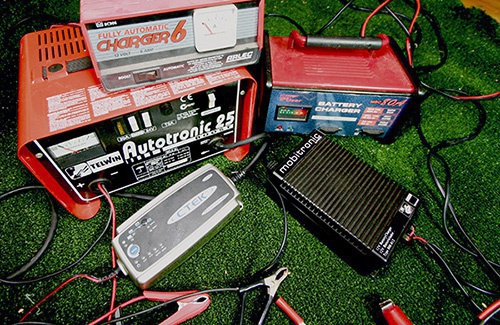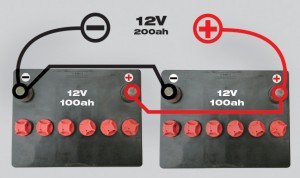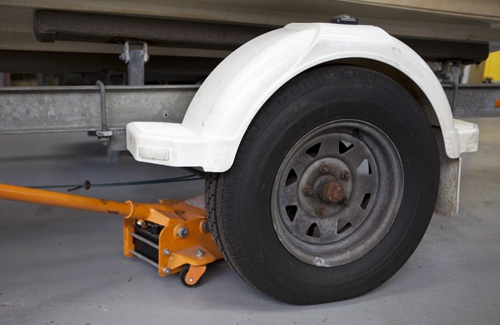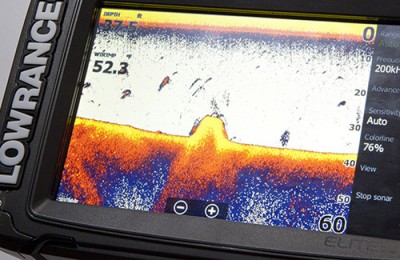This is the first part of a three part series on batteries. In this article we explain how to link batteries in a series circuit and a parallel circuit to obtain your required voltage and desired amp hours.
The first thing to remember when dealing with batteries and setting them up in different configurations, is that if you are unsure of what you are doing then take the job to an electrician! There are plenty of marine and auto electricians around, and they will be able to sort it all out in no time. Just ensure that they use tinned wire, switches, plugs, circuit breakers etc suitable for the marine environment.
This article will be of particular interest to anyone looking into buying or that owns an electric outboard motor. Electric motors come in many different sizes, the smaller ones are generally 12 volt while the bigger ones with more thrust are usually 24 volt, and then there are the really big ones which are usually 36 volt.
Series Circuit
Now some of you may be thinking that you have never seen a 36 volt battery, and you would be quite right. If you require 36 volts, you will need to link three 12 volt batteries up in a series circuit to obtain the higher voltage.
So in a series circuit we can increase voltage by the number of batteries. 3 x 12 volt equals 36 volt, or 2 x 12 volt equals 24 volt.
When linking batteries in a series circuit you will only increase the voltage, not the amp hours available. For instance if the 12 volt batteries used were 100 amp hours, the total amp hours for a 36 volt circuit would still be 100 amp hours.
To link batteries in a series circuit, get your batteries and battery connectors and cables ready, and ensure that there are no appliances or anything else hooked up to the batteries. Take your battery connector cable and run it from the negative terminal on one battery to the positive terminal on the other battery.
To run your higher voltage appliance, attach the red or positive cable to the empty positive terminal on one of the batteries and that should leave you with an empty negative terminal on the other battery to which you will attach the black or negative cable.
Parallel Circuit
Let’s say you had a 12 volt battery that ran the electric for one day, but you really wanted two days use out of it before needing to recharge the batteries again. If you had two 12 volt batteries at 100 amp hours and rigged them up in a parallel circuit you would get 12 volts and 200 amp hours. Three 12 volt batteries with 100 amp hours each in a parallel circuit would of course give us 12 volts and 300 amp hours.
To hook up a parallel circuit you will need to once again ensure nothing is hooked up to the batteries and that you have the connectors and cables on hand.
From here it is simply a matter of connecting the positive terminal on one battery to the positive terminal on the other battery and likewise with the negative terminal. When you attach your appliance you will simply attach the negative (black) cable to a negative terminal and the positive (red) wire to the positive terminal.

Batteries Part 2 – Battery Types
Don’t forget to check out Part 2 of our series on Batteries. It has all you need to know about choosing the right type of battery for the job.

Batteries Part 3 – Battery Charging
Want to learn more about the different types of battery chargers and how to ensure your battery lasts as long as it should? Check out Part 3 in our series on batteries!
Important Safety Information
When working on batteries in circuits please be very aware that any short between cables or battery terminals will be violent, especially if you are dealing with 24 volts and 36 volts. A touch of a spanner across battery terminals will all but vaporise the battery terminal in the blink of an eye.
In the worst case scenario you could also create an explosion due to the gasses present in a lead acid battery.
For this reason, it is wise to wear eye protection and long sleeves and never use a naked flame when working with batteries.
Important Tips
When you run circuits for your batteries it is important to remember a few things:
Never run more voltage into an electronic device than what it is designed for. For instance if you have a 12 volt electric motor never hook it up to 24 volt. This will either burn it out or reduce its functioning life drastically.
Always try and run exactly the same batteries in a circuit.
Always try to avoid running dissimilar amp hour rated batteries, this will put extra load onto one battery and shorten its life.
Always use the shortest leads possible between batteries and ensure these are in good condition and secured tightly.
When running power to an appliance ensure that the cable is heavy enough to cope with the amount of amps it is intended to supply.
As a cable gets longer it should also get thicker.If you have a power cable that gets warm or hot when you are running the appliance you should replace with heavier power supply cables.

Fishing WA in Luxury
Now you’ve got your batteries sorted, why not check out our article on travelling throughout Western Australia in the luxury of a modern caravan?











